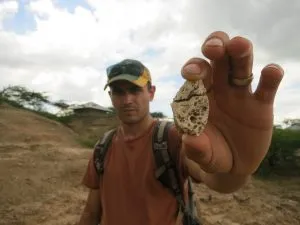 EVIDENCE DATES TO PERIOD OF UNPREDICTABLE, UNCERTAIN ENVIRONMENT
EVIDENCE DATES TO PERIOD OF UNPREDICTABLE, UNCERTAIN ENVIRONMENT
“These behavioral innovations may very well represent a response to rapid changes in the environment,” said Tyler Faith, curator of archaeology at the Natural History Museum of Utah, assistant professor of anthropology at the U, and coauthor of one of the three studies. “Such a response would have helped human populations endure climatic and environmental shifts that likely contributed to the demise of many other species in the region.”
An international collaboration, including the Natural History Museum of Utah at the University of Utah, has discovered that early humans in eastern Africa had—by about 320,000 years ago—begun trading with distant groups, using color pigments and manufacturing more sophisticated tools than those of the Early Stone Age. These newly discovered activities approximately date to the oldest known fossil record of Homo sapiens and occur tens of thousands of years earlier than previous evidence from eastern Africa. These behaviors, which are characteristic of humans who lived during the Middle Stone Age, replaced technologies and ways of life that had been in place for hundreds of thousands of years.
Evidence for these milestones in humans’ evolutionary past comes from the Olorgesailie Basin in southern Kenya, which holds an archeological record of early human life spanning more than a million years. The new discoveries, reported in three studies published March 15 in the journal Science, indicate that these behaviors emerged during a period of tremendous environmental variability in the region. As earthquakes remodeled the landscape and climate fluctuated between wet and dry conditions, technological innovation, social exchange networks and early symbolic communication would have helped early humans survive and obtain the resources they needed despite unpredictable conditions, the scientists say.
To better understand how climactic instability might have influenced the ecosystems in which the early humans at Olorgesailie lived, the research team integrated data from a variety of sources to assess and reconstruct the ancient environment. Faith and collaborators analyzed large mammal fossils from the archaeological sites. The bones told a story of massive turnover in the region—most species previously common in the Olorgesailie Basin had disappeared, and were replaced by others previously unknown in the basin. Some of the new ones are familiar species found in eastern Africa today, though others—including a massive zebra—are now extinct.
The team also saw evidence of dramatic range shifts, with some animals—such as the springbok, an antelope known today only from southern Africa—appearing in the basin. The faunal evidence, together with additional geological and paleoenvironmental indicators from Olorgesailie, show that the new adaptive behaviors that define earliest Homo sapiens were associated with large-scale changes in climates, faunas, and landscapes.
You can read the rest of the article here
Leave a Reply